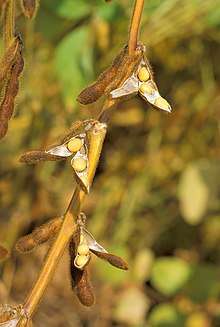Soybean sprout
| Soybean sprout | |||||||||
_2.jpg) | |||||||||
| Chinese name | |||||||||
|---|---|---|---|---|---|---|---|---|---|
| Traditional Chinese | 黃豆芽 | ||||||||
| Simplified Chinese | 黄豆芽 | ||||||||
| Literal meaning | yellow bean sprout | ||||||||
| |||||||||
| Vietnamese name | |||||||||
| Vietnamese | giá đậu nành | ||||||||
| Korean name | |||||||||
| Hangul | 콩나물 | ||||||||
| Literal meaning | bean namul | ||||||||
| |||||||||
| Japanese name | |||||||||
| Kanji | 豆萌やし | ||||||||
| Kana | まめもやし | ||||||||
| |||||||||
| Malay name | |||||||||
| Malay | tauge kasar | ||||||||
| Indonesian name | |||||||||
| Indonesian | kecambah kacang kedelai | ||||||||
Soybean sprout is a culinary vegetable grown by sprouting soybeans. It can be grown by placing and watering the sprouted soybeans in the shade until the roots grow long. Soybean sprouts are extensively cultivated and consumed in Korea.
History
It is assumed that soybean sprouts have been eaten since the Three Kingdoms of Korea.[1] Records of kongnamul cultivation are found in an early 13th century medical book, Emergency Folk Medicine Remedies published in Goryeo. The book states that in 935, during the foundation of Goryeo, a Taebong general Bae Hyeon-gyeong offered soybean sprouts to starving soldiers.[1]
Cooking methods of soybean sprout dishes are listed in Farm Management, a Joseon farming and living book. Another Joseon document, Literary Miscellany of Seongho, states that the poor used soybean sprouts to make juk (rice porridge). According to Complete Works of Cheongjanggwan, an essay collection from the Joseon era, soybean sprout was one of the main foods consumed during times of famine.
Culinary use
Korea
Soybean sprouts are one of the most common and basic ingredients in Korean cuisine. In Korean, the word kongnamul (콩나물) refers to both the soybean sprouts themselves and the namul (seasoned vegetable dish) made from soybean sprouts. The namul dish, made by stir-frying soybean sprouts with sesame oil and simmering it, is a common dish for jesa (ancestral rite). Another common side dish is kongnamul-muchim, made by seasoning boiled soybean sprouts. Soybean sprouts are also used in bibimbap and varieties of jjim dishes, such as agwi-jjim (braised angler). Sometimes, kongnamul-bap (rice cooked with soybean sprouts) eaten with herbed soy sauce constitutes a rustic meal. Clear soup made with soybean sprouts is called kongnamul-guk, which can also be served cold in summer. Kongnamul-gukbap or kongnamul-haejangguk (soybean sprout hangover soup) is usually served in a ttukbaegi (earthenware pot) with the rice in the bottom and the soup poured over the top. In Modern day South Korea, a spicy pork bulgogi dish made with a large number of soybean sprouts, called kongnamul-bulgogi (or kongbul), is popular among young people.
.jpg) Kongnamul-bulgogi before cooking, topped with soybean sprouts
Kongnamul-bulgogi before cooking, topped with soybean sprouts.jpg) Red kongnamul-muchim (seasoned soybean sprouts)
Red kongnamul-muchim (seasoned soybean sprouts) White kongnamul-muchim (seasoned soybean sprouts)
White kongnamul-muchim (seasoned soybean sprouts)
.jpg) Kongnamul-naengguk (cold soybean sprout soup)
Kongnamul-naengguk (cold soybean sprout soup)_(soybean_sprout_hangover_soup).jpg) Kongnamul-gukbap (soybean sprout hangover soup with rice)
Kongnamul-gukbap (soybean sprout hangover soup with rice) Agwi-jjim made with soybean sprouts
Agwi-jjim made with soybean sprouts
Nepal
In Nepalese cuisine, kwati, a soup of nine types of sprouted beans, is specially prepared in a festival of Janai Purnima which normally falls in the month of August. Kwati is prepared by frying and mixing onion, garlic, ginger, potatoes, spices and bean sprouts, including soybean sprouts. Lots of variation exist from house to house but is basically about making the kwati. It is considered as a nutritious food in Nepal. The so prepared kwati is normally eaten with rice. Sometimes meats (esp. fried goat meat) are also added to spice up the kwati.
See also
References
| Wikimedia Commons has media related to Soybean sprout. |
